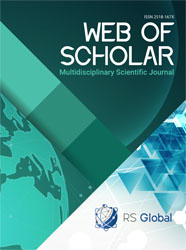СУЧАСНІ МОДЕЛІ ТА ФОРМИ ВИКОРИСТАННЯ ІНФОРМАЦІЙНО-КОМП’ЮТЕРНИХ ТЕХНОЛОГІЙ В ОСВІТІ
Abstract
The paper systematizes and describes the leading world approaches to the use of information and computer technologies in educational institutions in the process of modernization of current educational systems in accordance with the latest requirements of the information society. It is noted that the information society gives the humanity a fundamentally new tool of life that is characterized by the possibility of operating large volumes of information without territorial and time boundaries and displays information-knowledge at the level of the leading producer of public goods. All this leads to a review of the key functions of modern education, when the possession of information and computer technology becomes the main competence requirement for the pupil, student, and every person at each stage of his/her life.The authors substantiate the necessity of creating a system of "total computer literacy" and total informatization of the national education system, wide introduction in modern educational institutions of modern models and forms of use of information and computer technologies, introduction of the national education system to the global educational space at the institutional, environmental and personal levels. It is concluded that today our state faces a difficult task of ensuring the conformity of the basic approaches, principles and instruments of the educational process to the requirements of the transition to the era of the information society in regard to the modernization of the system of national education. We have to invest in the development of domestic innovative ICT products ahead of schedule. Technology and informatization of the educational process must become priority tasks of education reforms from pre-school education institutions to higher education and research institutions, in order not to stay away from the advancement towards the global information society.
References
О. І. Zhornova, «Information and communication technologies in higher education: to the formation of the readiness of subjects of education for innovation», Naukovi studii iz sotsial'noi ta politychnoi psykholohii, Vyp. 33, p. 172-179. 2013. (in Ukrainian)
Concept «New Ukrainian School». Approved by the decision of the Collegium of the Ministry of Education and Science of Ukraine of October 27, 2016. [online]. Available: https://goo.gl/OoaCWn. Accessed on: Mar. 07, 2019. (in Ukrainian)
Recommendation of the European Parliament and of the Council on key competences for lifelong learning. [online]. Available: http://europa.eu/legislation_summaries/education_training_youth/lifelong_learning/c11090_en.htm. Accessed on: Mar. 07, 2019. (in English)
T. V. Tarnavs'ka, «The essence of information technology in education». Visnyk Chernihivs'koho natsional'noho pedahohichnoho universytetu. Pedahohichni nauky, Vyp. 108.1, 2013, [online]. Available: http://nbuv.gov.ua/UJRN/VchdpuP_2013_1_108_31. Accessed on: Mar. 07, 2019. (in Ukrainian)
Declaration of Principles. Building the Information Society: a global challenge in the new Millennium. [online]. Available: http://www.itu.int/wsis/docs/geneva/official/dop.html. Accessed on: Mar. 07, 2019. (in English)
V. H. Shamonia, O. M. Udovychenko, A. O. Yurchenko, D. S. Bezuhlyj, «Activities of the research laboratory on the use of information technology in education: an overview of the results», Fizyko-matematychna osvita, Vyp. 4, р. 140-147, 2016. (in Ukrainian)
I. Malytska, «Global Educational Networks», Internet-portal «OSVITA.UA». [online]. Available: http://osvita.ua/school/method/technol/1120/. Accessed on: Mar. 07, 2019. (in Ukrainian)
N. T. Tverezovska, S. V. Yevstratiev, «Evolution and the current state of the use of information technologies in higher education in the USA, Japan and Europe», Naukovyj visnyk Natsional'noho universytetu bioresursiv i pryrodokorystuvannia Ukrainy,Vyp. 192 (2), р. 212-221, 2013. (in Ukrainian)
Hartmeyer, Helmuth, Wegimont, Liam, Global Education in Europe Revisited: Strategies and Structures. Policy, Practice and Challenges, Waxmann Verlag, 252 р, 2016.
Orr, Dominic, Rimini, Michele, Van Damme, Dirk, «Open Educational Resources: A Catalyst for Innovation». OECD, 143 р, 2016. (in English)
І. Bezzub, «The spread of information and communication technologies in education over a lifetime», Naukovi pratsi Natsional'noi biblioteky Ukrainy imeni V. I. Vernads'koho, Vyp. 48, р. 707-726, 2017. (in Ukrainian)
Davies, W. Keith, Longworth, Norman, Lifelong Learning, Taylor & Francis Group, 192 р., 2017. (in English)
«A Memorandum on Lifelong Learning», Commission of the european communities. [online]. Available: http://arhiv.acs.si/dokumenti/Memorandum_on_Lifelong_Learning.pdf/Accessed on: Mar. 07, 2019. (in English)
Eduroam now available in 101 countries. [online]. Available: https://www.eduroam.org/2018/11/07/eduroam-now-available-in-101-countries // Accessed on: Mar. 07,
(in English)
Keyes, Jessica, Bring Your Own Devices (BYOD) Survival Guide, CRC Press, 451 р., 2016. (in English)
G. P. Viter, О. О. Kucheruk, «Modern technological means and information technologies in education and science», Naukovyj visnyk Akademii munitsypal'noho upravlinnia. Seriia: Tekhnika,Vyp. 3, р. 8-12, 2010. (in Ukrainian)
A. V. Tadevosian, «Application of information technologies «e-education» in higher education as a necessary condition for overcoming the modern crisis and successful development in the XXI century», Biznes Inform, No 7, р. 245-247, 2012. (in Ukrainian)
O. Hot'ko, O. Chajkovs'ka, «Information and communication technologies - as a modern means of education in education», Molod' i rynok, No 4. р. 130-134, 2015. (in Ukrainian)
І. О. Dotsenko, «Actual problems of introduction of information and communication technologies in higher education», Hirnychyj visnyk, Vyp. 102, р. 117-120, 2017. (in Ukrainian)
Panitsides, Eugenia A., Lifelong Learning: Concepts, Benefits and Challenges, Nova Science Publishers, Incorporated, 148 р., 2016. (in English)
Views:
298
Downloads:
210
Copyright (c) 2019 The authors

This work is licensed under a Creative Commons Attribution 4.0 International License.
All articles are published in open-access and licensed under a Creative Commons Attribution 4.0 International License (CC BY 4.0). Hence, authors retain copyright to the content of the articles.
CC BY 4.0 License allows content to be copied, adapted, displayed, distributed, re-published or otherwise re-used for any purpose including for adaptation and commercial use provided the content is attributed.











